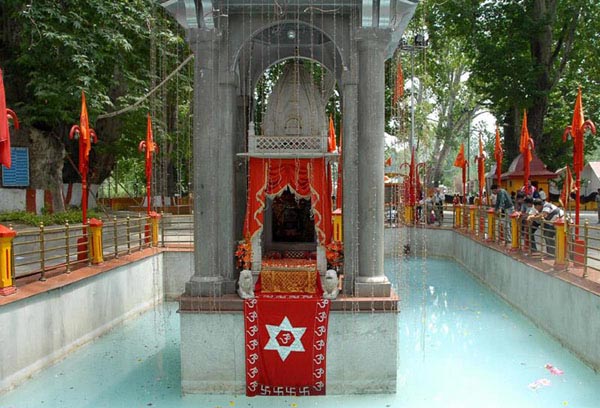Kheer Bhawani Temple

Information of Kheer Bhawani Temple, Srinagar, Jammu and Kashmir
The temple is situated in a small village named Tula Mula in Srinagar and is devoted to Goddess Kheer Bhavani. It has been build over a sacred spring and its prayer tends to be universal among the Kashmiris. The term kheer refers to a rice pudding which is offered to Maa Bhavani in the spring and thus became the name of the temple. There are numerous names of this Goddess such as maharagya Devi, Ragnya Devi, Ragnya Bhagwati and among others. The story of this temple is basically linked to Ramayan. It has been observed that the color of the spring water tends to alter according to time. Jyestha Ashtami festival is generally celebrated with great enjoyment in this temple. Hence, nearby 30000 Kashmiri Pandits make a visit to this temple in order to seek blessings from god.
Kheer Bhawani Temple Religious Importance
The temple tends to hold religious significance for the people of Jammu. The eighth day of the full moon day in the month of May possess great importance for Maa Bhavani devotees. People tend to observe fast on that day and visit the temple in order to offer their prayers. It is on this particular day Maa Bhavani alters the color of the spring water. During the Shukla Paksh Asthami day, 'havans' are conducted inside the temple in order to seek blessings from Maa Bhavani.
Kheer Bhawani Temple Mythology & History
It can be stated that the temple of Kheer Bhavani was constructed by Maharaja Pratap Singh during the year 1912. Later the renovation of the temple was done by Maharaja Hari Singh. The legend goes that Maharagya was quite happy with the prayer of Ravana. He appeared before Ravana and thus he obtained an idol of the Goddess that was installed in Sri Lanka. However, Goddess was quite displeased with the cruelty and shameless life of Ravana and thus demanded not to stay in Sri Lanka. It is often believed that in this regards, she ordered Lord Hanuman to shift the idol from Sri Lanka to Tula Mulla. Within the Kalhana's Rajtarangini, there is complete description of Kheer Bhavani temple which writes that the holy spring in Tula Mulla is located in a swampy ground. The spring is known as Mata Ragini Pond. It can be mentioned that both Tula Mulla as well as the spring is considered to be very holy in Rajtarangini. Furthermore, the Brahmins residing in Tula Mulla are paid due respect because of their spiritual power. Many years ago, a flood in Kashmir inundated the holy spring under its sway and this place could not be found. One day, in the dreams of Yogi Krishna Pandit Goddess came and ordered him that she would become a snake and would swim at an apt place. The duty of the Pandit was to stick big pole which would help in differentiating the holy place in the marsh land. Consequently, after the water settled there, the holy place was discovered. It is believed that Swami Rama Tirtha as well as Swami Vivekananda also visited this place in order to seek darshan of the Goddess.
Kheer Bhawani Temple Architectural Importance
The temple is bounded by streams and has numerous Chinar trees all around the temple area. Inside this area there is a hexagonal spring where the god of Goddess Regheneya has been well decorated and placed inside a small marble temple. The peaceful location and the serenity of the atmosphere add more beauty to the architecture, which is well accepted by the devotees here.
- Andhra Pradesh Temples
- Assam Temples
- Bihar Temples
- New Delhi Temples
- Goa Temples
- Gujarat Temples
- Jammu and Kashmir Temples
- Karnataka Temples
- Kerala Temples
- Madhya Pradesh Temples
- Maharashtra Temples
- Odisha Temples
- Punjab Temples
- Rajasthan Temples
- Sikkim Temples
- Tamil Nadu Temples
- Telangana Temples
- Uttar Pradesh Temples
- Uttarakhand Temples
- West Bengal Temples